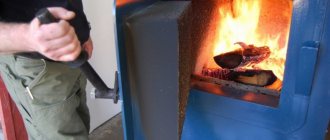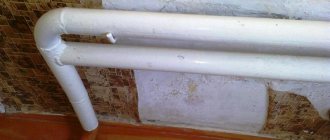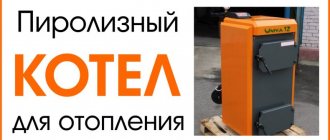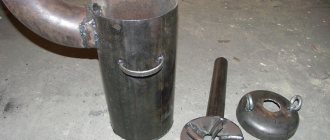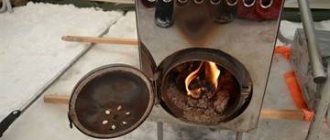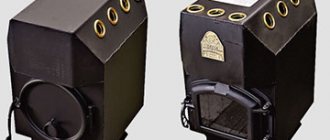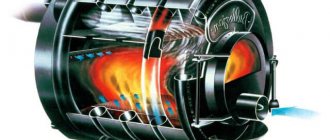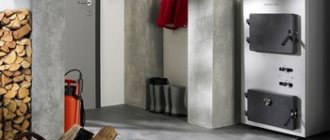Heating utility rooms, service stations, greenhouses and workshops is a pressing problem for many.
Boiler under development
It is not always possible to gasify these premises, and heating with electric appliances is very ineffective. An exhaust boiler with a water circuit is an excellent solution that allows you to use resources economically and efficiently.
In this article we will look at the principle of operation, the design of the boiler during testing and tell you how to build this unit with your own hands.
The main advantage of such a boiler is its fuel efficiency, because sometimes you can even get it for free. Many car services and workshops provide recycled oil on condition of pickup.
Principle of operation
The principle of boilers operating on recycled fuel is the same in all cases. It consists of evaporating the oil and burning the steam from it.
Principle of oil evaporation
But there are small nuances in this technology. All used oils contain many heavy metals, additives and other elements. The task is to build a unit that will allow you to accumulate heat inside, and not immediately discharge all these elements into the chimney. Complete oxidation of all elements occurs only if the maximum temperature inside the boiler is reached - 6000C.
The temperature indicator in this case is a very important point. Without going into lengthy explanations of chemical processes, we can say briefly: harmless combustion and evaporation of fuel can only occur at a temperature of 600 degrees. A deviation of 200 degrees to one side or the other will provoke the release of very harmful toxic substances.
Exhaust boiler with water circuit
A homemade boiler in operation looks like this: two metal containers are connected to each other by a pipe and at the same time they are at different heights. The upper tank is equipped with a smoke exhaust pipe, the length of which must be at least one meter.
Used oil is poured into the lower tank. The top layer of oil in the evaporation chamber heats up, resulting in the formation of steam. As it rises, it exits into a perforated pipe and connects with air, reaches the upper tank and burns. And the combustion products themselves are discharged through the pipe through the chimney.
Thus, the room is heated, but no toxic waste is released that is harmful to human health. This fact immediately answers the main question that interests many before building such a unit: “How harmful is a boiler during mining?”
Waste oil boiler diagram
With proper design and compliance with all necessary technical aspects, a waste fuel boiler does not pose a threat to human health. But here you need to strictly adhere to the operating conditions and understand that this unit is suitable for heating only utility rooms. Such a device cannot be used to heat a house. After all, it uses spent fuel, which is difficult to classify as a pure type of fuel.
You should clearly understand the operating principle and technology of oil evaporation in such a unit. It is not the oil itself that burns here, but its vapor. Due to the fact that the spent fuel heats up and begins to evaporate even before combustion begins, it becomes possible to decompose such burning fuel into lighter elements.
Where are such heating units used?
- in production premises;
- in premises for keeping animals;
- in auto repair shops, service stations;
- in greenhouses;
- in warehouses and garages.
Almost any oil, including shock-absorbing oil, can be used as fuel for such a boiler.
Conversion of a diesel device
Waste oil is tens of times more viscous than regular or stove diesel fuel.
Therefore, although the general principles of forming the air-fuel mixture are the same , the injector settings are very different.
Accordingly, the alteration directly depends on the design of the burner. In any case, you will have to change the fuel supply system and the device that forms the air-fuel mixture.
You can remake them according to the model of homemade ejector-type burners, because all the additional equipment is already on the diesel burner, or you can try to change the settings of the nozzle installed on the device.
You will find various ideas for such alterations and ways to implement them on thematic forums, links to which are located below :
- burnerclub.ru.
- termoportal.ru.
- forumhouse.ru.
Technology of oil evaporation in a boiler during production
Fuel combustion and oil evaporation can occur in two ways:
- Igniting a liquid substance. In this case, steam will be released, which will burn out in a special chamber.
- Pouring liquid onto a hot surface, resulting in the formation of steam.
One of the simplest ways to implement this technology is to use a hot metal bowl, onto the surface of which waste oil drips.
The principle of drip fuel supply
The bottom line is that upon contact with hot metal, the fuel abruptly evaporates rather than heats up. Diffusion of steam occurs with air, which is supplied to the tank. The vapors flash and burn, resulting in heat.
In order to achieve maximum efficiency of such a unit, it is necessary to ensure that the burning mixture remains in the combustion chamber for a long time. To do this, install a stationary impeller at the mouth of the chimney, which will help create the necessary turbulence in the combustion chamber.
A homemade boiler without a water circuit can heat a fairly large area. Its power is enough to heat a small workshop of 30-40 square meters, a greenhouse or a garage.
If it is necessary to provide heating for large rooms, then a boiler with a water circuit should be installed. At the same time, fuel consumption is striking in its efficiency: from 0.5 liters to 1 liter per hour.
Depending on the needs and desires of the owners of utility premises, such a home-made unit can be equipped with one or two circuits. If the task comes down solely to heating the room, then one circuit will be sufficient.
If you need to heat water for domestic purposes, then you need to make two circuits. For these purposes, a heat exchanger is installed in the upper tank.
Despite the excellent efficiency, versatility of fuel use and greater efficiency, this operating principle is rarely implemented on foreign boilers. But domestic manufacturers often produce units that are widely used for economic purposes.
The most difficult thing in independently performing such a design is the method of preheating the bowl onto which the oil is dripping. Those who make such a cauldron with their own hands do it simply: they throw a wick soaked in gasoline into the tank and set it on fire. Once the bowl is heated to the desired temperature, simply turn on the oil supply.
Boiler under development
The second point that you need to pay attention to is the uniform drip supply of oil. It is necessary to ensure an optimal level of spent fuel filtration.
To do this, just put a car oil filter on one end of the tube, which is lowered into the spent fuel tank. The filter must be changed at least once a month. If the fuel is dirty, then more often.
Another problem can be the fuel pump, which must supply the right amount of oil to the tank. By assembling a structure from fittings, a nipple and two tees, you can achieve “protection” from fuel overflow. The hose will contain a portion of oil that is placed in this unit.
Pump
The rest will simply flow back into the tank. The factory design of the boiler with automatic overflow protection is carried out according to a similar scheme.
Another idea for drip fuel delivery is to use a piece of a regular medical drip. This fragment is put on the lower fitting, and the frequency of drops is determined using the regulator wheel.
The amount of fuel that drips onto the bowl should be just enough so that it burns evenly, but does not smoke. If the fuel changes, the drop frequency must be adjusted again each time.
A good modern boiler for testing must be equipped with protection against oil boiling and fuel overflow. To avoid a fire, you need to ensure that the oil level in the reservoir is lower than in the stove itself.
In order to make a boiler with a water circuit, it is enough to arrange a water jacket around the furnace body. This circuit can then be used at your own discretion: either to heat a large room or to heat water.
In order to connect the pipes leading to the heating system to the tank, you will need a pump to circulate water.
The boiler during testing seems to be good for everyone: it is both economical and easy to operate. But how to ensure that it maintains combustion for a long time?
A way to prolong the combustion
You cannot add oil while it is operating - it is dangerous. Waiting for complete combustion is inconvenient. You can, of course, make a large fuel reservoir, but then a large amount of oil will not have time to heat up to the required temperature.
An additional tank will help solve this problem, where the main fuel supply will be filled. It will be connected to the lower body according to the principle of communicating vessels.
How does the burner work?
There are 2 types of burners:
- evaporators (drip);
- injectors (supercharged).
The basis of the drip burner is the evaporator bowl into which fuel slowly drips.
Part of the waste burns in the bowl, increasing the temperature there and starting the pyrolysis process, while the other part evaporates and breaks up into volatile hydrocarbons and other gases, which rise above the bowl, mix with the incoming air and burn.
The fuel supply system monitors the amount of fuel in the bowl and either opens the valve to replenish the amount of liquid, or closes it to prevent waste from overflowing.
The main advantages of the evaporator are:
- simplicity of design;
- the ability to function in training of any quality.
The injector works differently. First, the fuel is heated to make it more fluid, then it is fed under pressure through a calibrated hole into the mixer, into which air is pumped. In the mixer, waste and air are mixed, after which they exit the nozzle into the combustion zone.
The mixture can be ignited using an open fire, an electric arc or a hot metal plate. They regulate the power of the injector by changing the volume of air supply and oil pressure , so that the ratio of fuel to fuel will always be the same.
If you do not have experience in making such devices, then make an evaporator, because it is easier not only to assemble, but also to configure, but it is almost twice as efficient.
Advantages and disadvantages of a boiler during development
Like any heating unit, an exhaust boiler has its advantages and disadvantages. Before you decide to do it yourself, we suggest you familiarize yourself with this list in detail.
Advantages:
- low cost of resources;
- simple design and clear operating principle of the boiler;
- the ability to use a boiler to heat water (when constructing a water circuit);
- rapid heating of liquid;
- possibility of making it yourself;
- compactness;
- high efficiency.
The relative environmental safety of such a boiler can be considered more of an advantage, but it should be emphasized that this safety is achieved only with strict adherence to all technical nuances during construction and operation.
DIY boiler
The “output” boiler produces a temperature of 95 degrees, which allows you to properly heat a garage, greenhouse, or workshop even in the most severe frost.
You can provide a small hob on the structure, with which you can easily heat a kettle or heat up lunch.
Flaws:
- the need for regular cleaning;
- lack of support for this unit at the legislative level;
- unpresentable appearance.
As you can see, this heating design has many more advantages than disadvantages. Therefore, if you decide to build an exhaust boiler with a water circuit yourself, we offer you step-by-step instructions that even a beginner can handle.
Equipment operating rules
The assembled water boiler must be used in compliance with certain rules, the main one of which is the use of a chimney with a suitable cross-sectional diameter. The smoke exhaust system must be equipped with a damper to regulate draft, and the section of its passage through the ceiling and roof is insulated using a heat-resistant casing. And when using the boiler, it is not allowed to add fuel to the heated chamber, cool the boiler with water and turn off the forced-air fan. Compliance with these rules will ensure efficient operation of the equipment and increase the service life of the heating system.
Fire safety measures
It should be understood that such a home-made structure must be made strictly in accordance with established fire safety standards.
To protect the premises from fire, we also recommend adhering to the following rules:
- The chimney diameter must be at least 100 mm. Ideally, use sandwich pipes, on the surface of which a minimum amount of soot is formed.
- It is prohibited to store flammable items (fuel tanks) in the immediate vicinity of the tanks.
- All joints must be sealed.
- The thickness of the walls of the tanks where fuel combustion occurs must be at least 4 mm.
- To ensure the flow of fresh air into the room and to avoid smoke, it is necessary to equip the boiler room with a forced circulation system. The air exchange rate per 1 cubic meter of area is 180 m3/hour.
Types of units
If you need to organize heating in your home, it is better to purchase a boiler in a standard version. Such designs currently have sufficient autonomy and safety. Comfort and ease of use is also due to the fact that there are no specific odors emitted by fuel.
The boiler operates in automatic mode. This makes it possible to use it without special knowledge and experience. The process of burning oil is designed in such a way that it burns completely without the accompaniment of fumes and the smell of gas.
Heating structures
Such units should not be installed in residential areas. Usually special extensions are used for this. Although the boilers are equipped with modern filters, during operation you can smell the smell of machine oil.
The design of the device has a built-in heating unit, consisting of a water pipe and a pump, which operates not only from the mains voltage, but also from the energy of the device itself. Thanks to it, water circulates evenly in the system.
The operating principle of such devices is based on the combustion of a mixture of fuel and air supplied by a compressor fan. The strength of the fire is regulated using a regular hose, at the end of which a valve is installed.
Water heating devices
The function of these devices is to heat water. They can be called ordinary boilers. They have a platform operating principle: a tank of water is installed on a heated surface. The pump built into the outlet serves to adjust and equalize the pressure inside the system.
This is interesting: the principle of operation of the boiler.
It should be noted that it will be quite difficult to regulate the constant temperature of the liquid. Inside the tank it can reach +80...100°C. Often, such heating systems use coolant containers with a volume of 60–140 liters. The process by which water is heated lasts about 2 hours, which is almost half less than in a boiler.
The hot water boiler has two operating modes. With fast, cold water is heated in the shortest possible time (the automatic switch is in the “wick” mode). In this case, a lot of fuel is consumed, and if the container is small, carbon monoxide emissions are likely.
Appliances
Another subtype of devices of this kind are household boilers. These are multifunctional devices. More often, such designs are used in houses that do not have a water heating circuit. They are equipped with a fairly good gas purification system, which eliminates soot and smoke during operation of the device.
Fuel consumption is very low compared to previous types. Mobility is the main advantage of such a device. It can even be transported in the trunk of a car and used on trips, for example, to nature. In this case, it serves as a cooking stove and also as a heater. The main thing is to provide the fireproof platform or recess in the ground of 30-40 cm required for installation.



